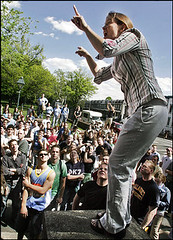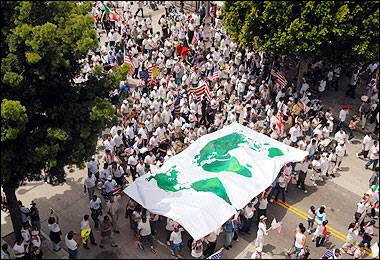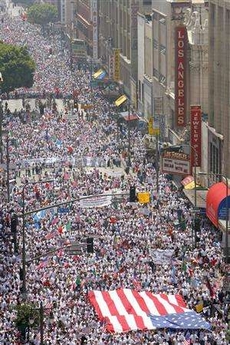What people protest...
 Gallaudet announces its new choice for President, and much of the student body holds a rally at the front gate to protest that choice. Pictured, Alumnus Tawny Holmes, last year's student body government president, addresses a crowd of students that has gathered at the Florida avenue entrance to campus. Washington Post photo by Bill O'Leary.
Gallaudet announces its new choice for President, and much of the student body holds a rally at the front gate to protest that choice. Pictured, Alumnus Tawny Holmes, last year's student body government president, addresses a crowd of students that has gathered at the Florida avenue entrance to campus. Washington Post photo by Bill O'Leary.___________
Update: Also see "More about current Gallaudet student protests" from Saturday, May 06, 2006
___________
I went to a University with about 35,000 students. It was large, and undergraduate classes teemed with students. Even upper level courses could have more than 100 students, at least in the social sciences, which is what I studied (if you didn't figure that out already).
The president of the university at the time, Harold Shapiro, didn't say "hi" either. Instead at the time, he was focused on rebuilding the University Hospital and downsizing the university (I wrote about this before) in the face of drastic reductions in appropriations from the State of Michigan.
Eventually, the university just ended up dramatically raising tuition, although they did downsize or eliminate a few programs. Tuition in 1978 was $550/term (plus fees) for in-state students. In today's currency that would be about $1,650, so for the year $3,300. This year, in-state tuition at the University of Michigan is about $9,000 for lower-division undergraduates. (Inflation-adjusted calculation performed at Economic History Net.)
So, in short, it's hard for me to take seriously the current Gallaudet student protest over the choice of Provost Jane Fernandes as President, in part because she is seen as aloof. From "Gallaudet Students Continue Protests Against New President," in the Washington Post:
"They complained that the board of trustees once again was ignoring the campus community; some decried the lack of racial diversity among the finalists -- all of whom are white. Others focused on personality, saying Fernandes was cold, aloof, condescending. "She doesn't say 'hi,' " one student's poster read, along with a new rallying cry: "Better president now."
Give me the recent immigration protests, or the anti-crime protest in Venezuela... or see this webpage on the original Deaf President Now movement at Gallaudet. I did pick up a phone book sized compilation of the original DPN press coverage a few months ago at Capitol Hill Books (a used bookstore on Capitol Hill). It's inspiring--as Provost Fernandes herself says, Dr. I. King Jordan is a tough act to follow. And I am all for civility... still it seems hard to get worked up over this.
Also see Blair Kamin's piece in the Chicago Tribune, "Room to be heard: Immigration rallies remind us why public spaces are vital." From the article:
Not long ago, some big thinkers pronounced public space dead and fingered the computer as the culprit. There was no point in waxing nostalgic about old-fashioned parks and plazas, they argued, when the Internet was allowing people to gather in the virtual realm of chat rooms irrespective of where they lived. "The real public space is invisible to the eye," the renowned Dutch architect Rem Koolhaas proclaimed at a 1999 Harvard symposium.
No one must have conveyed this spurious bit of analysis to the hundreds of thousands of people who poured into Chicago's Federal Plaza, Washington's National Mall and other places around the nation in recent weeks to protest proposed federal laws that would crack down on illegal immigrants. They could not have been more visible.
Whether you agreed with the protesters or not, they demonstrated one fact beyond dispute: Public spaces are very much alive. The latent power of parks and public squares to serve as stages for mass marches that propel issues onto the national agenda--a characteristic embodied by the 1963 civil rights march on Washington and Rev. Martin Luther King Jr.'s ringing "I Have a Dream" speech--remains undiminished.
True public space, like true democracy, can be disruptive, even unruly. The public square is not a mall or a theme park, insulated and isolated from reality. It's serendipitous, not controlled; open to all, not restricted to the privileged few. Here, the have-nots can confront the haves and the outs can harangue the ins--sometimes with deadly consequences.
 People march down Broadway in support of immigrant rights in downtown Los Angeles, California on 01 May 2006. The US Senate will make a new attempt this month to agree on immigration reforms, a top Republican said after more than one million people demonstrated for immigrant rights.(AFP/Getty Images/File/Jaime Rector).
People march down Broadway in support of immigrant rights in downtown Los Angeles, California on 01 May 2006. The US Senate will make a new attempt this month to agree on immigration reforms, a top Republican said after more than one million people demonstrated for immigrant rights.(AFP/Getty Images/File/Jaime Rector). Thousands of demonstrators march through the streets of downtown Los Angeles May 1, 2006, as part of a nationwide protest staged by immigrant rights advocates to protest proposed legislation to reform U.S. immigration law. REUTERS/Lucas Jackson.
Thousands of demonstrators march through the streets of downtown Los Angeles May 1, 2006, as part of a nationwide protest staged by immigrant rights advocates to protest proposed legislation to reform U.S. immigration law. REUTERS/Lucas Jackson.Index Keywords: protest; -engagement



1 Comments:
The "doesn't say 'hi'" thing was a smokescreen being talked about the pro-Fernandes PR department at the time, as a ploy to counter the protest. One single person held up such a sign early in the protest. It's not clear who that person was (and it could have been a plant). Thanks.
Post a Comment
<< Home